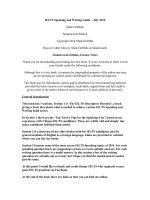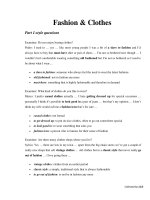IELTS Speaking Sample: Art and architecture
Bạn đang xem bản rút gọn của tài liệu. Xem và tải ngay bản đầy đủ của tài liệu tại đây (56.59 KB, 6 trang )
Art and architecture
Part 1
1.
Do you enjoy drawing and painting? Why or
why not?
I don’t really sure about what feelings I have for them. To be honest, almost all forms of art,
especially painting, are too abstract for me to fully understand. However, sometimes I was
moved by several masterpieces, MonaLisa drawn by Leonardo DaVinci for example. I have
always thought about her mysterious smile since I saw a copy of this painting on a website.
2.
What things do you like to draw?
Many things honestly. The subjects of my paintings are often picked randomly, for example,
people, patterns, household facilities, etc, but my main inspiration is landscape as only this
topic seems to show great potency for my level. It is also because I cannot take my eyes off the
marvellous sceneries of nature and was inspired by them immediately.
3.
Are you good at art?
Art is a really vast subject, I believe that if it is about drawing things here and there, I would
say I am pretty fine at it. But, I am surely not one of those who can make some masterpieces.
You know, the paintings of mine are just some scrawls which were created in my spare time.
4.
Did you enjoy drawing and painting when you
were a child? Why?
Well I believe every kid on Earth does have a passion for drawing and I am no exception. When
I was a child, in primary school I think, I actually had a crack at painting and insisted on joining
a training class. My mom was so annoyed that she eventually allowed me to do this, but then I
realised I don't have any talent in art so I quitted. Now I also spend some of my free time
drawing, but just for fun, you know.
5.
What kind of things did you do in Art lesson
at school?
It is so embarrassing to confess that since I was a high school student, I have never paid any
attention to what the Art teacher said in the lessons. Art is actually not my cup of tea and Art is
not a mandatory subject in high school. But as I remember having participated in one in
secondary school, all the students had to stand for ages just to measure the proportion of a
flower vase. Can you believe that? It’s so dull!!! Therefore, rather than using my valuable time
for such an exhausting activity, I often go outside and do some sports. At least it is useful, right?
6.
Do you have any art in your home?
Well, I am actually not a culture vulture or sth, so of course I don’t have any interest in
collecting pieces of Art. But I sometimes hang out with my friends and go to art galleries to see
some paintings of local artists.
7.
How often do you often visit art galleries?
Quite often I think. Despite the fact that art is not my cup of tea, I enjoy the time being with my
friends or family at art galleries.
8.
Do you like taking pictures?
Absolutely yes. Taking photos is one of my favorite activities whenever I have the opportunity
to travel to different places. I consider it as a way to mark every memorable moment in my life,
for example, when my family gathers for an anniversary.
9.
What do you do with the pictures you take?
Well, unlike the majority of modern people who constantly post the taken photos on social
media like Facebook or Instagram, I always put them in an album as a keepsake. If I feel down
and discouraged, I will gaze at it immediately and my spirits will be lifted right away.
10.
Do you think art is an important part of life?
Yes, if there was no art, everyone and everything would be the same. There would be no
entertainment. Life would be dull; we would all just work and go crazy. If we didn’t have art,
we would all be robots.
11.
Do you think art classes are necessary?
Yes, definitely. Learning art, especially at a young age, can help stimulate children’s cognitive
development and encourage them to think outside the box. Because they’re still little, their
ideas are very fresh and lovely, which is worth appreciating.
12.
Is art popular in your country?
Art is truly respected in my country. People who can draw well are surely in demand in fields
like army, police and country development. Recently, our prime minister hired twenty great
artists from our country to create designs that will be painted on the walls of rural areas which
are not very developed. He has a vision to ensure that everyone lives in a nice livelihood.
13. Do schools in Vietnam have field trips to
museums?
Not all schools in Vietnam have field trips to museums, which I think is a shame. In my
viewpoint, every educational institution should launch such kinds of schemes. Many children
get bored of the everyday routine of school. Field trips give children a chance to learn outside
of traditional classroom settings and can spark new interests in.
14. Do you think going to museums and galleries
is beneficial for children?
Yes, museums and galleries are a great educational tool since they act as windows into the past
better than any text books. Having said that, I believe children can learn more about history and
culture. Art can broaden their minds and their outlooks on life. It can also inspire them to be
more creative, to have original ideas, and to be inventive.
15.
What kinds of paintings do people like?
In my opinion, people love hanging landscape paintings at home. Bringing in the beauty of
Mother Nature somehow eases people’s mind after a long day at work. Another style of
drawing that most people also like is portrait. It could be portraits of someone important to
them or even their lovely pets.
16.
Is it easy to learn to draw?
I think I must say it’s even challenging for a lot of people. I absolutely failed when it comes to
drawing still life paintings like fruit and flowers. I think for those who succeed in drawing or
arts in general, they first must have God-gifted talent, then come to the long-term commitment
to arts that requires extreme practice and high patience.
Part 2
1.
Describe a photograph that you like. You
should say:
● When and where the photo was taken
● What can you see from the photo
● How you keep this photo
and explain why you like this photo.
I’ve probably seen and taken thousands of pictures in my whole life. However, my favorite one
is the 12-year-old photo of me where I was sitting in the middle of my parents and
grandparents.
It was an old back-and-white photograph and the corners of it were faded. I don't have a clear
memory regarding the event when this picture was taken, but I have seen it many times and still
look at it in a bittersweet mood. I look with amazement into the picture and cannot believe I
was so small and different looking at that time. Also, it gives me a gloomy feeling as my
grandfather is no longer with us.
In the photo, I was wearing a full sleeve shirt, full pants and a pair of white shoes and obviously
I am the focal point of this picture. Other family members were standing around me, with my
parents on the right and my grandparents on the left. I can vividly remember that my dad was
very stylish and high-fashion when he was young, so he put on jeans and a jacket which had a
great vogue at that time. My grandfather had spectacles on his eyes and got his hair backbrushed. Both my mom and grandma were wearing Ao dai, which is our Vietnamese traditional
clothes. They looked so fresh and elegant in the photo.
My family kept it in a wooden frame and hung it in the living room. I use it as my phone’s
background image so that I can see it whenever I check the device.
I love this picture so much as it conveys my grandparents’ memory and depicts a happy family.
I gaze at it almost every single day. That’s because it gives me positive energy when I’m feeling
blue and discouraged. Just by looking at it, my spirits are lifted right away.
2.
Describe a work of art. You should say:
● What it is.
● Where you saw it
● What is it about
and explain why you like it.
Honestly, I’m not very keen on painting or sculpture, so this is really a tough topic for me. But
if you ask me to talk about an art masterpiece, the one that comes to my mind first is the
MonaLisa, an oil painting by the famous Italian Renaissance artist Leonardo da Vinci. You’ve
possibly heard of this work of art.
Well, actually, I’ve never seen the original painting, which is said to be on display in the French
Louvre Museum. I remember the first time I saw it was when I was in primary school. It was a
reproduction in the official textbook on art history.
The picture is really amazing. The painting shows a woman looking out at the viewer with an
‘enigmatic smile’. When you look at MonaLisa, no matter where you stand, you’ll find her
looking and smiling at you.
My art teacher told us that the MonaLisa is perhaps the most famous piece in art history and is
probably the most widely known portrait in the Western world. My teacher also told us that
people could learn a lot about other cultures through their paintings, which I believe is quite
true. Having heard of this masterpiece’s significance, I have nurtured the dream of leaving my
footprints in Paris to have a look at the original painting.
Part 3
1.
What benefits can you get from painting as a
hobby?
I think the mediation efficiency is worth mentioning first. Colors in some ways reflect our
thoughts and emotions very well and somehow stimulate our body to defend against our
negativity inside. For me, in particular, I think what’s so interesting about painting is that you
have no idea how harmonized colors can become until you actually try. Moreover, painting
allows us to be creative, to make choices and helps in healing. So, it is not just about painting
the perfect portrait but about letting your thoughts on the paper. When people do it , it really
affects their psychology making them happier and more content with life.
2.
Why do people enjoy art?
We, humans, are “unique” in our existence and experience. Therefore, it is only natural that we
have our needs and expectations that are unique as well. But among those unique needs and
expectations that separates us from animals, enjoying art seems to be something that makes us
“truly” unique as humans.
So, what is the general purpose of art? Well, the answer is, art helps us to look at ourselves a
little “closer” in a different light by explaining our desire and expectation in more details which
otherwise wouldn’t be possible. With the help of art, we are able to communicate our social,
political, cultural and spiritual ideas in a much more organized manner so that we feel
“challenged” to rethink the issues and the subjects that are affecting us and our surroundings on
a daily basis.
We enjoy art because it stimulates our hearts and minds to appreciate our lives in a more
positive light. We enjoy art also because it makes us feel different by combining our “unusual
motifs” that weave their way into our “subconscious” (or the “hidden” us) and alter our mood
so that we feel free to travel into a different realm.
3.
Do you think that art is as important as
academic subjects when it comes to educating
children?
Pablo Picasso once said that “every child is an artist. The problem is how to remain an artist
once he grows up”. Therefore, offering children the much-needed space to create, to explore
and to express themselves through art is absolutely important so that a holistic approach to
education can be ensured. However, the purpose of art as academic subjects is not, and should
not be, taught in a standardized way just to produce some produced artists, but to provide a
means of exploring feelings and experiences. This is something that every child can enjoy and
benefit from. In other words, the children should be able to find the true value of “art” in the
process itself as well, not only in the “end product”.
4.
What are the advantages and disadvantages
of art education?
There are a number of advantages that art education can bring. In fact, many studies suggest
that art education has many social and academic benefits to students as it promotes self-directed
learning, sharpens creative problem-solving skills and critical thinking. The arts provide
challenges for learners at all levels by connecting them with their own culture as well as with
the rest of the world. Studies also suggest that integrating art education with other disciplines
helps reach the students who otherwise would feel discouraged in class works.
However, there are some disadvantages to art education as well. Learning art can be timeconsuming and sometimes can take decades to finish a piece of work. Another major
disadvantage of art is, by forcing people to learn it, in general, learners wouldn’t exactly
understand the idea of art, and therefore, wouldn’t exactly learn to appreciate art. I think
whether it is drama, painting, or music, if this is the case, then it can be really depressing and
de-motivating for the aspiring artists.
5.
Why do you think some people enjoy looking
at paintings and sculptures and others do not
The fact that some people enjoy looking at paintings and sculptures while others don’t, can be
attributed primarily, in my opinion, to how much art education one has received. Besides, this is
also an issue of sensibility and how emotionally we get triggered by certain artworks. In fact, as
I have read somewhere, there is a theory which explains that because colours, shapes, sounds
and thoughts are all waves form, and the more we are sensitive to these kinds of waves, the
better we can understand an emotional message, considering that a piece of painting or
sculpture essentially is an expression of an emotion, or transmit it. As a result, we will highly
appreciate those works of art and enjoy looking at them.
6.
What are the advantages and disadvantages
of being an artist?
On a metaphysical level, an advantage of being an artist is that he/she has a heightened
sensitivity to the surroundings and being able to nurture it with a childlike playfulness towards
experiences throughout the entire life. This is because they have the satisfaction of creating
something beautiful and special. But on a practical level, being an artist allows one to work
independently, and therefore mitigates many problems which arise in the workplace.
However, one of the major disadvantages of being an artist is that he/she is not financially
solvent most of the time, and he/she has to rely on some other sources of income to survive.
And, as a result, an artist has no or a very limited social life. Another disadvantage that is worth
mentioning is public attitudes. Most people don’t take art as an actual profession, which can be
equally demoralizing and frustrating for an artist who has a high sense of self-respect.
7.
Do you think that some people are naturally
better artists than others?
I’m not sure about this question but I think the answer would probably be yes: just like
somebody is better in science and mathematics academically, primarily because of their genetic
structure and disposition towards creativity. In fact, it is my opinion that it is the genetic
disposition when children spent much of their time in their childhood engaging in creative
activity, whether it was drawing or singing, or whatever that they enjoyed. Therefore, they can
develop their essential skills through the process of play. Of course, some people would choose
to argue that it is the artists’ passion that drives them to become successful. But, even if I agree
with them to some extent just for the sake of debate, I would still argue that if it is not for their
natural inclination or disposition, they wouldn’t be able to turn themselves into some better
artists.








